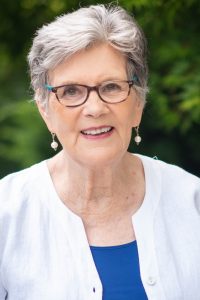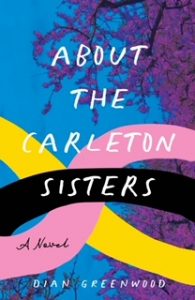Interview with Dian Greenwood, Author of ABOUT THE CARLETON SISTERS
 After growing up in the Dakotas, Dian Greenwood came to the West Coast during adolescence. She is a writer and family therapist in Portland, Oregon. Her debut novel, ABOUT THE CARLETON SISTERS, is due out June 13 from She Writes Press.
After growing up in the Dakotas, Dian Greenwood came to the West Coast during adolescence. She is a writer and family therapist in Portland, Oregon. Her debut novel, ABOUT THE CARLETON SISTERS, is due out June 13 from She Writes Press.
The novel features a Las Vegas showgirl, a diner waitress, and a heartbroken alcoholic—three sisters—who are called into an obligatory reunion in California’s Central Valley in the late 1990s as a prelude to their mother’s impending death. It takes readers on a compelling, high-spirited ride through each sister’s perspective as they navigate middle age, generational trauma, and each other.
Q: ABOUT THE CARLETON SISTERS explores sisterly bonds in the face of a major life event. What was the genesis of the book for you? How would you describe each sister’s personality? What drives their estrangement and their coming back together?
A: What inspired the novel was an incident at a 12-step meeting in 1988. My sister and I were in this meeting and when she talked about our family, she had an entirely different experience than me. I realized there was a story there—about different perspectives on the family by each member. I think the emotional landscape of CARLETON SISTERS is based on that. Even though Lorraine was the first character I wrote, Julie was the character I was going after. Julie is really the icon for the American fantasy of beauty. Lorraine is that meat-and-potatoes practicality—a fundamentalist Christian with this shadowed dishonesty. She’s trying to cheat her sisters out of their inheritance. And Becky is the heartbroken alcoholic who felt the father’s abandonment most severely. She was the one the mother blamed. After the father left, Becky turned her attention to surviving the pain of his abandonment.
Q: Tell me about your decision to sign a book contract with She Writes Press. For the uninitiated, what’s a “hybrid” press? And, did the fact that She Writes publishes women authors exclusively come into play for you?
I learned about hybrid presses in 2013 during a conference in Seattle, where I pitched this novel to several agents. In one of the workshops, a woman named April Eberhardt—she’s still an agent—talked about hybrid presses, a cooperative venture between author and publisher that results in a very professional book. It’s like self-publishing with a quality press. After too many years and no luck with an agent, then more years submitting to small presses, I decided on She Writes Press, which offers national distribution. And yes, I love the idea of publishing with a women-only press. It’s taken about two-and-a-half years from acceptance of the manuscript to publication.
Q: Is CARLETON SISTERS a literary novel, a commercial novel, or cross-genre? Would it be a good book club choice?
A: I think it’s a combination. I said “literary fiction” and She Writes said “women’s fiction,” so that’s the way it’s been promoted. I think it is a book club book. It would generate a lot of questions about sibling relationships and about choices and non-choices women make about their lives.
Q: You started writing CARLETON SISTERS 25 years ago, when you were much younger. You’re now 81. How does it feel to have your first work of fiction enter the world as an octogenarian?
A: Of course I wish I had published this novel at 59 when I thought it was finished. But this is the way it’s finally happening! My age lends an urgency to the task. Though I’m twice-divorced and the mother of two grown sons, my most solid marriage has been to writing. I started writing poetry when I was a student at San Francisco State University, and turned to serious novel writing in the 1990s. Publication feels like the culmination of a life well-lived.
Q: It’s often said that writing is a lonely, solo experience. You continued refining SISTERS throughout the pandemic, during that long period of isolation. How did you find momentum, and community, in that effort?
A: I started CARLETON SISTERS in Los Angeles in the late ’90 when I studied with WHITE OLEANDER author Janet Fitch. When I moved to Oregon, I joined the Dangerous Writers, a workshop led by author and teacher Tom Spanbauer, while working on other novel projects. After that I participated in a critique group called the Henry Writers. I think the writing community in the Portland area is cutting-edge in its quality. The rainy weather has everything to do with this—it’s conducive to the solitude you need to write, the ability to go deep and take risks. This is a huge reading community, and very generous-hearted. It’s like a giant ecosystem—interdependent. People like to share.
Q: Before you turned to fiction writing, you wrote poetry. You still do. How do those two forms feed your sense of self and the way you continue to move in the world?
A: I was studying poetry in San Francisco when Ann Rice’s novel INTERVIEW WITH THE VAMPIRE came out. I was in my early 30s, and arrogant. I thought, “Well, if she can do it, so can I.” I’ve had several bad “trainer” novels. In the ’80s I worked with the poet Richard Hugo for two summers. He influenced my voice. What I love about his poetry is that it’s plainspoken but gets to the emotional heartbeat of what makes a person human. I tried to emulate that in CARLETON SISTERS.
Q: You’re someone who believes in the power of women in literature. Has identifying as female informed your vision for what you want to write?
A: As I matured, I recognized that so many great novels were focused on women finding agency. Like Virginia Woolf’s A ROOM OF ONE’S OWN, a very important work for me. I landed in the Bay Area in 1967, newly divorced, working in advertising. On the one hand I was reading Helen Gurley Brown, and on the other, Betty Friedan’s THE FEMININE MYSTIQUE. At that time, I could always get a job as a secretary, but no one would hire me as an account executive. I noticed early on that men had certain advantages in terms of salary and positions. I think I was trying to lift myself out of my working class beginnings. I was a single mother. I’d already realized marriage wasn’t the best vehicle for that even though I’d been married to a doctor. I tended to choose men who wanted a traditional life, a traditional wife. It took me years to figure that I didn’t fit that mold. I was 45 when I went to grad school a second time to get my marriage and family therapy degree. What I needed was work that would satisfy my writing life, work that would take me into my 80s.
Q: It’s every Portland author’s dream to stand behind the podium at Powell’s City of Books. Your book launch is scheduled for June 21, the first day of summer. It sounds like the stars aligned!
A: I’ve been attending launches for over 20 years—supporting authors, buying their books. It’s been incredible. The writing community here is what’s kept me in Portland. I’ve already bought the outfit I’ll wear on June 21. I’ll be nervous, no doubt, and emotional. One of the ways I’ve learned to deal with fear is to just say it up front. Laura Stanfill, my friend and publisher of Portland’s Forest Avenue Press, is going to introduce me. And I’ll be in conversation with the wonderful author Rene Denfeld—we both write about mostly working-class people. I’m so grateful for these women. It’s magical that it’s happening on the summer solstice.
Q: CARLETON SISTERS has a colorful, eye-catching cover. What do you like best about it?
A: I like the vibrancy of it, and the way the artist intersected three ribbons—the sisters, of course—and included the branches of trees that represent the almond orchards in the novel. I like the script, too. And I appreciate the authors who took the time to read and recommend the book with their fantastic blurbs.
Q: Once ABOUT THE CARLETON SISTERS has its “book birthday,” Dian Greenwood fans can look forward to three more novels: FOREVER BLACKBIRDS, its sequel SAFEKEEPING, and BERT & EILEEN, in the not-too-distant future. Can you give us a peek into those stories and tell us what they mean to you?
A: FOREVER BLACKBIRDS and SAFEKEEPING are historic novels, inspired by my maternal grandmother. I had a vision for writing about four generations of women in the same family. In BLACKBIRDS, a novel written in dual timelines, the protagonist, Marta, is a 45-year-old woman with her family’s men in the military durimg World War II. The other timeline is 1914, when Marta is 14 and immigrating with her family from Russia, today’s Ukraine. SAFEKEEPING features Marta’s namesake granddaughter in her mid-60s. She’s going through a divorce and attends a self-help meditation retreat in Minnesota, trying to find herself. Her granddaughter comes to visit her. Together, they return to the small North Dakota town where the BLACKBIRDS protagonist lived her life. BERT & EILEEN deals with issues of aging, failing health, and death. Also what happens when adult children step in, thinking they know what’s best for their elderly parents. That one’s set in Portland, and it’s told over the period of a single year. BLACKBIRDS and SAFEKEEPING are much more sweeping. CARLETON SISTERS takes place over one summer.
—
Find out more about Dian on her website https://diangreenwood.com/
Follow her on Twitter https://twitter.com/GreenwoodDian
ABOUT THE CARLETON SISTERS
Category: On Writing

 A Las Vegas showgirl, a diner waitress, and a heartbroken alcoholic—three sisters—are called into an obligatory reunion in California’s Central Valley in the late 1990s as a prelude to their mother’s impending death.
A Las Vegas showgirl, a diner waitress, and a heartbroken alcoholic—three sisters—are called into an obligatory reunion in California’s Central Valley in the late 1990s as a prelude to their mother’s impending death.






















